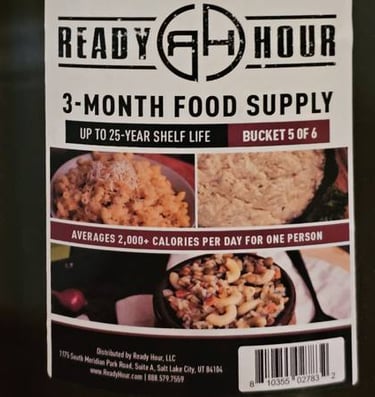
The Ultimate Guide to Self-Sufficiency: Homesteading for Beginners
Embark on a journey towards self-sufficiency with this comprehensive guide to homesteading. Learn essential skills, tips, and resources to start your own homestead and live a more sustainable and fulfilling life.
David Hess
11/13/20246 min read



In a world increasingly reliant on technology and mass production, the allure of self-sufficiency has grown stronger than ever. Homesteading offers a path to a more sustainable, fulfilling, and independent lifestyle. By growing your own food, raising livestock, and harnessing renewable energy, you can reduce your reliance on the modern grid and live more in harmony with nature.
This comprehensive guide will equip you with the essential knowledge and skills to embark on your homesteading journey. From choosing the right land to planning your homestead, from growing your own food to raising livestock, and from harnessing renewable energy to preserving your harvest, we'll cover it all.
Choosing Your Homestead
The first step to starting a homestead is finding the right piece of land. Consider the following factors when selecting your homestead:
Location: Choose a location with access to water, fertile soil, and good sunlight.
Size: The size of your homestead will depend on your goals and resources.
Climate: Consider the climate of your region and choose plants that are well-suited to your local conditions.
Zoning Laws: Be sure to check local zoning laws to ensure that your homesteading activities are permitted.
Planning Your Homestead
Once you've chosen your homestead, it's time to start planning. Here are some key considerations:
Your Goals: Determine your primary goals for your homestead. Are you looking to grow your own food, raise livestock, or become completely self-sufficient?
Your Skills and Experience: Assess your current skills and knowledge, and identify areas where you may need additional training or education.
Your Budget: Set a realistic budget for your homesteading project.
Your Time Commitment: Consider how much time you can dedicate to your homestead.
Creating a Sustainable Homestead
Sustainability is a key principle of homesteading. Here are some tips for creating a sustainable homestead:
Conserve Water: Use water-efficient irrigation systems and collect rainwater.
Reduce Waste: Compost food scraps and recycle materials.
Use Renewable Energy: Consider solar, wind, or hydro power to reduce your reliance on fossil fuels.
Practice Permaculture: Permaculture is a design system that mimics natural ecosystems. It can help you create a more sustainable and productive homestead.
Growing Your Own Food
Growing your own food is a rewarding and essential part of homesteading. Here are some tips for successful gardening:
Choose the Right Plants: Select plants that are well-suited to your climate and soil conditions.
Prepare the Soil: Improve your soil by adding compost or other organic matter.
Plant at the Right Time: Plant your seeds or seedlings at the appropriate time of year.
Water Your Plants Regularly: Water your plants deeply and consistently.
Weed Your Garden: Remove weeds to prevent competition for nutrients and water.
Fertilize Your Plants: Use organic fertilizers to nourish your plants.
Protect Your Plants from Pests and Diseases: Use natural pest control methods to protect your plants.
Harvest Your Crops: Harvest your crops at the peak of ripeness.
Preserve Your Harvest: Preserve your harvest by canning, freezing, or drying.
Raising Livestock
Raising livestock can provide you with a steady supply of meat, eggs, and milk. Here are some tips for raising livestock:
Choose the Right Livestock: Consider your climate, space, and experience level when choosing livestock.
Provide Adequate Housing and Shelter: Ensure your animals have a safe and comfortable place to live.
Feed Your Animals Properly: Feed your animals a balanced diet of high-quality feed.
Provide Clean Water: Ensure your animals have access to clean, fresh water.
Monitor Your Animals' Health: Keep an eye on your animals' health and seek veterinary care when needed.
Harnessing Renewable Energy
Renewable energy can help you reduce your reliance on fossil fuels and save money on your energy bills. Here are some options for harnessing renewable energy on your homestead:
Solar Power: Solar panels can generate electricity to power your home and appliances.
Wind Power: Wind turbines can generate electricity in windy areas.
Hydropower: If you have a water source, you can use hydropower to generate electricity.
Preserving Your Harvest
Preserving your harvest is essential for year-round food security. Here are some common methods of food preservation:
Canning: Canning is a great way to preserve fruits, vegetables, and meats.
Freezing: Freezing is a simple way to preserve fruits, vegetables, and meats.
Drying: Drying is a good way to preserve herbs, fruits, and vegetables.
Pickling: Pickling is a great way to preserve vegetables.
The Spiritual Dimension of Homesteading
Homesteading can be a deeply spiritual experience. It connects us with the natural world and reminds us of our dependence on God. Here are some ways to incorporate spirituality into your homesteading practice:
Gratitude: Express gratitude for the abundance of nature.
Mindfulness: Practice mindfulness while gardening and other homesteading activities.
Connection with Nature: Spend time in nature and appreciate its beauty.
Community: Build relationships with other homesteaders and share your knowledge and skills.
Stewardship: Take care of the land and resources entrusted to you.
The Benefits of Homesteading
Homesteading offers numerous benefits, both physical and mental. Some of the key benefits include:
Improved Physical Health: Gardening and other physical activities associated with homesteading can improve physical health, reduce stress, and boost immunity.
Mental Health Benefits: Spending time in nature and engaging in productive activities can reduce stress, anxiety, and depression.
Financial Savings: Growing your own food, raising livestock, and generating your own energy can significantly reduce your expenses.
Environmental Impact: By reducing your reliance on store-bought food and industrial products, you can minimize your carbon footprint.
Community Building: Homesteading can connect you with like-minded individuals and foster a sense of community.
Essential Skills for Homesteaders
To be a successful homesteader, you'll need to develop a variety of skills. Here are some essential skills to master:
Gardening: Learn how to plant, care for, and harvest various crops.
Food Preservation: Master techniques like canning, freezing, and drying to preserve your harvest.
Livestock Care: Learn how to raise chickens, goats, pigs, or other livestock.
Home Repair and Maintenance: Develop basic carpentry, plumbing, and electrical skills.
Financial Management: Learn how to budget, save, and invest wisely.
Survival Skills: Acquire skills like foraging, hunting, and fishing.
Overcoming Challenges
Homesteading is not without its challenges. Here are some common challenges and how to overcome them:
Time Commitment: Homesteading requires significant time and effort. Prioritize tasks and delegate responsibilities when possible.
Physical Labor: Physical labor is a major part of homesteading. Stay physically fit and take breaks when needed.
Weather and Climate: Be prepared for unpredictable weather conditions and adjust your plans accordingly.
Pests and Diseases: Learn to identify and control pests and diseases in your garden and livestock.
Financial Constraints: Start small and gradually expand your homestead as your budget allows.
The Spiritual Dimension of Homesteading
Homesteading can be a deeply spiritual practice. It connects us to the natural world and reminds us of our dependence on God. Here are some ways to incorporate spirituality into your homesteading journey:
Gratitude: Express gratitude for the abundance of nature and the opportunity to live a self-sufficient life.
Mindfulness: Practice mindfulness while gardening and other homesteading activities.
Connection with Nature: Spend time in nature and appreciate its beauty.
Community: Build relationships with other homesteaders and share your knowledge and skills.
Stewardship: Take care of the land and resources entrusted to you.
Conclusion
Homesteading is a rewarding and fulfilling lifestyle that can provide numerous benefits. By embracing a self-sufficient lifestyle, you can reduce your reliance on the modern system, improve your health, and connect with nature. Remember, the journey to self-sufficiency is a lifelong learning process. Be patient, be persistent, and enjoy the process.
Additional Tips:
Start Small: Begin with small, manageable projects and gradually expand your homestead.
Learn from Others: Seek advice from experienced homesteaders and join online forums and communities.
Document Your Journey: Keep a journal to track your progress and lessons learned.
Share Your Knowledge: Teach others about homesteading and inspire others to live a more sustainable lifestyle.
Embrace Failure: Don't be afraid to make mistakes. Learn from your failures and keep moving forward.
By embracing the art of homesteading, you can create a more meaningful and sustainable life for yourself and your family.
Use Promo Code :
JAM-2781 For $10 Off!!











